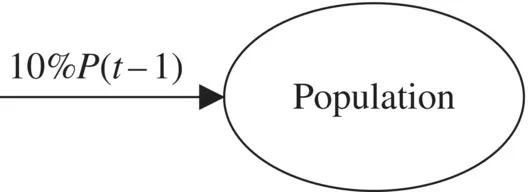
Solutions Manual to Accompany Models for Life
An Introduction to Discrete Mathematical Modeling with Microsoft Office Excel
- English
- ePUB (mobile friendly)
- Available on iOS & Android
Solutions Manual to Accompany Models for Life
An Introduction to Discrete Mathematical Modeling with Microsoft Office Excel
About This Book
A solutions manual to accompany An Introduction to Discrete Mathematical Modeling with Microsoft ® Office Excel ®
With a focus on mathematical models based on real and current data, Models for Life: An Introduction to Discrete Mathematical Modeling with Microsoft ® Office Excel ® guides readers in the solution of relevant, practical problems by introducing both mathematical and Excel techniques.
The book begins with a step-by-step introduction to discrete dynamical systems, which are mathematical models that describe how a quantity changes from one point in time to the next. Readers are taken through the process, language, and notation required for the construction of such models as well as their implementation in Excel. The book examines single-compartment models in contexts such as population growth, personal finance, and body weight and provides an introduction to more advanced, multi-compartment models via applications in many areas, including military combat, infectious disease epidemics, and ranking methods. Models for Life: An Introduction to Discrete Mathematical Modeling with Microsoft ® Office Excel ® also features:
- A modular organization that, after the first chapter, allows readers to explore chapters in any order
- Numerous practical examples and exercises that enable readers to personalize the presented models by using their own data
- Carefully selected real-world applications that motivate the mathematical material such as predicting blood alcohol concentration, ranking sports teams, and tracking credit card debt
- References throughout the book to disciplinary research on which the presented models and model parameters are based in order to provide authenticity and resources for further study
- Relevant Excel concepts with step-by-step guidance, including screenshots to help readers better understand the presented material
- Both mathematical and graphical techniques for understanding concepts such as equilibrium values, fixed points, disease endemicity, maximum sustainable yield, and a drug's therapeutic window
- A companion website that includes the referenced Excel spreadsheets, select solutions to homework problems, and an instructor's manual with solutions to all homework problems, project ideas, and a test bank
Frequently asked questions
Information
1
DENSITY INDEPENDENT POPULATION MODELS
1.1 EXPONENTIAL GROWTH
- Consider the flow diagram in Text Figure 1.21.
 Text Figure 1.21 Flow diagram for Exercise 1.1.1.
Text Figure 1.21 Flow diagram for Exercise 1.1.1.- Find the corresponding DDS.The flow diagram tells us how the population changes from one year to the next. Inward pointing arrows represent additions while outward pointing arrows represent subtractions. Here there is only one arrow, and it represents an addition. Thus the DDS is given by
 We can also write the DDS as, or
We can also write the DDS as, or .
.
- Use a calculator to predict the population after 2 years if .
 If, then by using the DDS we can predict the population 1 year later:
If, then by using the DDS we can predict the population 1 year later:
 Applying the DDS once more gives us the model prediction for year 2:
Applying the DDS once more gives us the model prediction for year 2: After 2 years we predict the population will be 60.5.
After 2 years we predict the population will be 60.5. - Use Excel to project the population in year 10.Since the model in this problem is the exponential growth model, we can save time by using the same spreadsheet we created for the Yellowstone grizzly population. We only need to change the growth rate toand the initial population to
 . Figure 1.1 shows the result with the projection for year 10 highlighted. The model predicts a population of about 129.7 in year 10.
. Figure 1.1 shows the result with the projection for year 10 highlighted. The model predicts a population of about 129.7 in year 10.
 Figure 1.1 Excel output for Exercise 1.1.1.
Figure 1.1 Excel output for Exercise 1.1.1.
- Find the corresponding DDS.
- Consider the flow diagram in Text Figure 1.23.
 Text Figure 1.23 Flow diagram for Exercise 1.1.3.
Text Figure 1.23 Flow diagram for Exercise 1.1.3.- Find the corresponding DDS.The flow diagram tells us how the population changes from one year to the next. Inward pointing arrows represent additions while outward pointing arrows represent subtractions. Here we have two arrows: one an addition and one a subtraction. Thus the DDS is given by
 We can also write the DDS as, or
We can also write the DDS as, or .
.
- Use a calculator to predict the population after 2 years if .
 If, then by using the DDS we can predict the population 1 year late...
If, then by using the DDS we can predict the population 1 year late...
- Find the corresponding DDS.
Table of contents
- Cover
- Title Page
- Table of Contents
- PREFACE
- ABOUT THE COMPANION WEBSITE
- 1 DENSITY INDEPENDENT POPULATION MODELS
- 2 PERSONAL FINANCE
- 3 COMBAT MODELS
- 4 THE SPREAD OF INFECTIOUS DISEASES
- 5 DENSITY DEPENDENT POPULATION MODELS
- 6 BLOOD ALCOHOL CONCENTRATION AND PHARMACOKINETICS
- 7 RANKING METHODS
- 8 BODY WEIGHT AND BODY COMPOSITION
- End User License Agreement